|
|
 |
Fiche d'espèce de Copépode |
|
|
Calanoida ( Ordre ) |
|
|
|
Lucicutiidae ( Famille ) |
|
|
|
Lucicutia ( Genre ) |
|
|
| |
Lucicutia magna Wolfenden, 1903 (F,M) | |
| | | | | | | Syn.: | Lucicutia atlantica Wolfenden, 1904 (p.121, Descr.F); Farran, 1905 (p.44); Pearson, 1906 (p.25, Rem.); Wolfenden, 1911 (Rem.: p.316, fig.F as Disseta atlantica: lapsus calami); Sars, 1925 (p.217, figs.F,M); Rose, 1933 a (p.196, figs.F,M); Jespersen, 1934 (p.105); 1940 (p.51); Lysholm & al., 1945 (p.35); Sewell, 1948 (p.503, 508, 514, 547); Davis, 1949 (p.56, Rem.F,M); C.B. Wilson, 1950 (p.255); Mazza, 1966 (p.71:?); Bainbridge, 1972 (p.61, Appendix Table III: occurrence); Kovalev & Shmeleva, 1982 (p.84); Suarez-Morales & Gasca, 1998 a (p.110); Hernandez-Trujillo & Esqueda-Escargera, 2002 (in Appendix);
Lucicutia gracilis Sars, 1905 c (p.8); Yamaguchi & al., 2002 (p.1007, tab.1); Ikeda & al., 2006 (p.1791, Table 2);
no Lucicutia magna (M): Wilson, 1932 a (p.130, fig.M) | | | | Ref.: | | | Wolfenden (in Fowler, 1903, p.124, Descr.M); Farran, 1908 b (p.62); 1926 (p.276); Wolfenden, 1911 (p.316, figs.F); Farran, 1929 (p.209, 264); Wilson, 1932 a (part., p.130, figs.F); Sewell, 1947 (p.174); Tanaka, 1963 (p.36, figs.F,M, Rem.); Hülsemann, 1966 (p.727, fig.M); Owre & Foyo, 1967 (p.77, figs.F,M, Rem.); Bradford, 1970 a (p.357, fig.M); Roe, 1984 (p.358); Chihara & Murano, 1997 (p.830: tab.5); Bradford-Grieve & al., 1999 (p.883, 945, figs.F,M); Bradford-Grieve,1999 b (p.105, figs.F,M, Rem., figs.177, 191); Boxshall & Halsey, 2004 (p.133: F; p.135: M); Vives & Shmeleva, 2007 (p.341, figs.F,M, Rem.) | 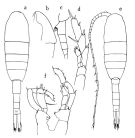 issued from : O. Tanaka in Publs Seto Mar. Biol. Lab., 1963, XI (1). [p.37, Fig.165]. Female: a, habitus (dorsal); b, head (left lateral side); c, urosome (left lateral side); d, P5. Nota: the urosome segments and furca are in the proportional lengths as 27:17:14:13:29 = 100. Male: e, habitus (dorsal); f, P5. Nota: the urosome segments and furca are in the proportional lengths as 11:18:16:14:10:31 = 100. The furcal rami 5-times as long as wide.
|
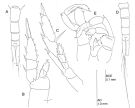 issued from : J.M. Bradford-Grieve in The Marine Fauna of New Zealand: Pelagic Calanoid Copepoda. National Institute of Water and Atmospheric Research (NIWA). NIWA Biodiversity Memoir, 111, 1999. [p.106, Fig.70]. Female (from 45°52'S, 171°18'E): A, urosome (dorsolateral); B, P1; C, P5. Male (from 42°24.5'S, 174°01.8'E): D, urosome (dorsal); E, P5.
|
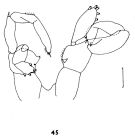 issued from : J.M. Bradford in N.Z. Jl Mar. Freshw. Res., 1970, 4 (4). [p.357, Fig. 45]. Male (off Kaikoura, New Zealand): 45, P5 Scale bar represents 0.1 mm.
|
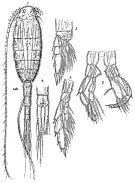 Issued from : G.O. Sars in Résult. Camp. Scient. Prince Albert I, 69, pls.1-127 (1924). [Pl.LIX, figs.1-12]. As Lucicutia atlantica. Female: 1, habitus (dorsal); 2, P1; 3, P5; 4, anal segment and caudal rami (dorsal). Male: 5, P5.
|
 Issued from : K. Hülsemann in Bull. Mar. Sc., 1966, 16 (4). [p.728, Fig.119]. Male: 119, P5.
|
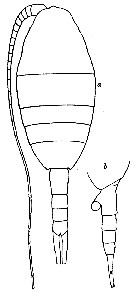 issued from : R.N. Wolfenden in Die Marinen Copepoden der Deutschen Südpolar-Expedition 1901-1903, 1911. [p.317, Fig.59]. Female: a, habitus (dorsal); b, posterior part cephalothorax and urosome (lateral, left side).
|
 issued from : R.N. Wolfenden in Die Marinen Copepoden der Deutschen Südpolar-Expedition 1901-1903, 1911. [Pl.XXXV, Fig.5]. As Disseta atlantica. Female: 5, urosome (dorsal).
|
 issued from : R.-M. Barthélémy in These Doc. Univ. Provence (Aix-Marseille I), 1999. [Fig.17, D, E]. Female: D, external ventral view genital double-somite. gp = gonoporal plate; opercular pad arrowed; asterisk = cuticular outgrowth hidding the gonoporal plates. Scale bars: 0.100 mm (D); 0.020 (E).
|
 issued from : H.B. Owre & M. Foyo in Fauna Caribaea, 1, Crustacea, 1: Copepoda. Copepods of the Florida Current. 1967. [p.77, Fig.499]. Female: 499, P5.
|
 Lucicutia magna Lucicutia magna female: 1 - Characters following not combined : Prosome about 3 times longer than urosome. Cephalosome with slightly projecting and rounded anterior corners and well developed lateral spinous projections; anal somite about as long as wide; caudal rami 11.7 times longer than wide and bowed outwards at base, leaving elliptical space between rami proximally. 2 - P1 with 2-segmented endopod. 3 - Cephalosome not with 2 pairs of lateral spinous projections, but with other forms. 4 - Distal 4 to 5 segments of A1 reaching beyond tip of caudal ramus. 5 - Caudal rami shorter than urosome and 5 times longer than wide. 6 - Terminal setal element of P5 up to half the length of 3rd exopodal segment.
|
 Lucicutia magna Lucicutia magna male: 1 - P1 with 2-segmented endopod; 2 - Caudal rami less than 10 times longer than wide. 3 - Inner distal corner of basis of P5 without strong spine. 4 - Inner margin of basis of left P5 ornamented with 2 pointed process at midlength; basis of right leg with 1 spinous process.
| | | | | Ref. compl.: | | | Hardy & Gunther, 1935 (1936) (p.179, Rem.); Sewell, 1948 (p.330, 521, 549); De Decker & Mombeck, 1964 (p.13); Grice & Hulsemann, 1965 (p.224); Furuhashi, 1966 a (p.295, vertical distribution in Kuroshio region, Table 9); 1967 (p.17); Park, 1970 (p.477); Roe, 1972 (p.277, tabl.1, tabl.2); Björnberg, 1973 (p.343, 387); Deevey & Brooks, 1977 (p.256, tab.2, Station "S"); Pipe & Coombs, 1980 (p.223, Table II, vertical occurrence); Vives, 1982 (p.293); Suarez & al., 1990 (tab.2); Suarez & Gasca, 1991 (tab.2); Suarez, 1992 (App.1); Webber & Roff, 1995 (tab.1); Shih & Young, 1995 (p.70); Kotani & al., 1996 (tab.2); Suarez-Morales & Gasca, 1998 a (p.110); Razouls & al., 2000 (p.343, tab. 5, Appendix); Holmes, 2001 (p.18); Fernandes, 2008 (p.465, Tabl.2); Galbraith, 2009 (pers. comm.); Park & Ferrari, 2009 (p.143, Table 4, Appendix 1, biogeography); Medellin-Mora & Navas S., 2010 (p.265, Tab. 2); Bonecker & a., 2014 (p.445, Table II: frequency, horizontal & vertical distributions); Fierro Gonzalvez, 2014 (p.1, Tab. 3, 5, occurrence, abundance); El Arraj & al., 2017 (p.272, table 2); | | | | NZ: | 19 | | |
|
Carte de distribution de Lucicutia magna par zones géographiques
|
| | | | | | | | | | | | | | | | Loc: | | | Antarct. (SW Atlant., Indian, SW Pacif.), South Georgia, sub-Antarct. (SW Atlant.), Malvinas Is., South Africa (E), G. of Guinea (off Lagos), off Morocco-Mauritania, Canary Is., off Canary Is., off Portugal, Azores, Brazil,off Rio de Janeiro, Barbada Is., Caribbean Sea, Jamaica, Caribbean Colombia, G. of Mexico, Florida, Sargasso Sea, off Bermuda (Station "S"), off Woods Hole, S Strait of Davis, S Iceland, Wyville Thomson Ridge, Faroe Is., Porcupine Bank, off W Ireland, Bay of Biscay, off W Cape Finisterre, Ibero-moroccan Bay, Medit. (NW Basin), Indian, Bay of Bengal, Philippines, China Seas (South China Sea), Japan (Izu, Onagawa), Tori Is., Station Knot, NE Pacif., off British Columbia, S California, New Zealand (Kaikoura, E South Island, NE North Island, off N), N Tasman Sea, W Ecuador, off E Easter Is., N Chile | | | | N: | 59 | | | | Lg.: | | | (1) F: 3,5; (21) F: 3,9-3,4; M: 3,4-3,1; (26) F: 3,6; M: 3,43-3,15; (35) F: 3,9; (38) F: 3,36; (45) F: 3,5; (59) F: 3,8-3,4; M: 3,4; (199) F: 3,57-3,12; M: 3,34-3,12; (313) M: 3,55; (909) F: 3,3-3,9; M: 3,2-3,3; {F: 3,12-3,90; M: 3,10-3,55}
| | | | Rem.: | épi, méso-bathypélagique.
Sampling depth (Antarct., sub-Antarct.) : 500-1000 m.
Certaines localisations dans le Pacifique nécessitent confirmation.
Cette espèce est probalement entraînée par la dérive north atlantique
Voir aussi les remarques en anglais | | | Dernière mise à jour : 24/10/2022 | |
|
|
 Toute utilisation de ce site pour une publication sera mentionnée avec la référence suivante : Toute utilisation de ce site pour une publication sera mentionnée avec la référence suivante :
Razouls C., Desreumaux N., Kouwenberg J. et de Bovée F., 2005-2026. - Biodiversité des Copépodes planctoniques marins (morphologie, répartition géographique et données biologiques). Sorbonne Université, CNRS. Disponible sur http://copepodes.obs-banyuls.fr [Accédé le 07 janvier 2026] © copyright 2005-2026 Sorbonne Université, CNRS
|
|
 |
 |











